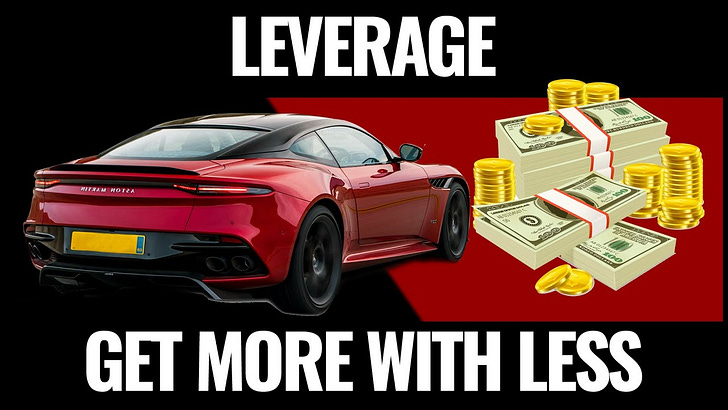How I Stopped Fearing Debt — And Started Understanding Wealth
From Buffett’s float, Kiyosaki’s mindset, and why the right kind of debt isn’t dangerous—it’s a tool.
It was a Saturday evening—warm, slow, quiet.
Not the kind of day where anything dramatic happens. I was sipping chai, flipping through notes on valuation models, and casually browsing YouTube when a familiar face popped up: Robert Kiyosaki, holding a marker, saying something that made me freeze:
“Debt is money.”
Wait—what?
I had read Rich Dad, Poor Dad before, but this time, something about the way he said it hit different. Until then, debt had always felt like a red flag. Something to run away from. A warning, not a weapon.
Growing up in a middle-class Indian family, debt was almost taboo. Personal loans were scary. Credit cards were for emergencies. Home loans were okay—but only if you spent the rest of your life paying them off cautiously. The unspoken rule was:
"If you owe someone, you're trapped."
But that evening, sitting with ₹15,000 in my account and a thousand dreams in my head, I started wondering:
What if I’ve misunderstood debt all along?
Debt = Bad? Or Just Misunderstood?
Let’s be clear: bad debt—credit cards for gadgets, EMIs for depreciating items, or borrowing to consume—can absolutely ruin your finances. I knew that much.
But what if debt, when used to acquire assets that grow or pay you, could actually build wealth?
That’s what Kiyosaki meant when he said:
“There’s good debt and bad debt. Good debt puts money in your pocket. Bad debt takes it out.”
— Robert Kiyosaki
I was curious. One video became two, then three, then an article rabbit hole. Each source pulled me deeper into an idea I’d never seriously considered:
The rich use leverage. Not recklessly. But intentionally.
Realizations from Buffett to Kiyosaki
I knew Warren Buffett was conservative. But what I didn’t know?
Berkshire Hathaway consistently used 1.6–1.7x leverage for decades.
Not by taking loans—but through something called insurance float.
“Buffett gets to invest billions of dollars that aren’t even his. The cost of this float is often close to zero. That’s the best kind of debt.”
— Carson Group
Here’s how it works: Berkshire owns insurance companies. They collect premiums now but only pay claims later. That “in-between money” is float—and Buffett invests it, often beating inflation and growing capital.
You can even see him explain it in a 1998 Q&A. It’s not noisy or flashy. But it’s smart leverage—with low cost and no panic.
On the flip side, I watched Tom Wheelwright, Kiyosaki’s tax advisor, explain how Robert himself uses over $1.2 billion in debt to legally reduce taxes, acquire appreciating assets, and keep multiplying wealth.
Two different legends. Same principle: Don’t fear debt. Use it wisely.
Comparison: Consumer Debt vs Wealth-Building Debt
Cultural Mindset: Why We Fear Debt
Debt is personal. Especially in Indian homes.
You may have seen relatives go bankrupt after a failed loan. Heard your dad say, “Karz leke ghar nahi chalte.” Or felt shame about even using a credit card.
But what we often forget is: That’s bad debt. Not all debt.
We confuse pain from irresponsible borrowing with the power of strategic borrowing.
In fact, some of the most successful Indian entrepreneurs—from Dhirubhai Ambani to today’s unicorn founders—used debt as fuel. They didn’t avoid it. They understood it.
Videos That Changed My Thinking
How Debt Can Generate Income – Robert Kiyosaki
Debt is a tool, not a trap.
Good Debt vs Bad Debt – Kiyosaki Deep Dive
What kind of debt to use.
Warren Buffett on Float (1998 Q&A)
Buffett’s quiet leverage engine.
Articles That Anchored My Understanding
What’s My Next Step?
Now, when I hear “debt,” I pause—and ask:
Will it build an asset?
Is there a repayment plan from the asset itself?
Is my risk hedged?
If the answers align, I’ll use it. If not, I’ll wait. But I won’t run away anymore.
Final Reflection
As an investor, i always scout for low cost and flexible debt.
ICICI Direct and Kotak Securities gives me MTF at less than 10% p.a.. I can use that to buy stocks at right times. Interest applies daily and as soon as i get cash inflows, i use them to repay them immediately.. All digital, all quick….
Use existing assets that you have built, like home, mutual funds and others to get a secured loan. They cost much less and comes at 8-10% p.a. Pre-payments are free. Process is mostly hassle free..
Any other debt in this range. It has to be flexible and prepaid immediately as the requirement vanishes.
More i am confident of making much higher returns in markets and use my cash flows judiciously, more I can take leverage to achieve my goals….



